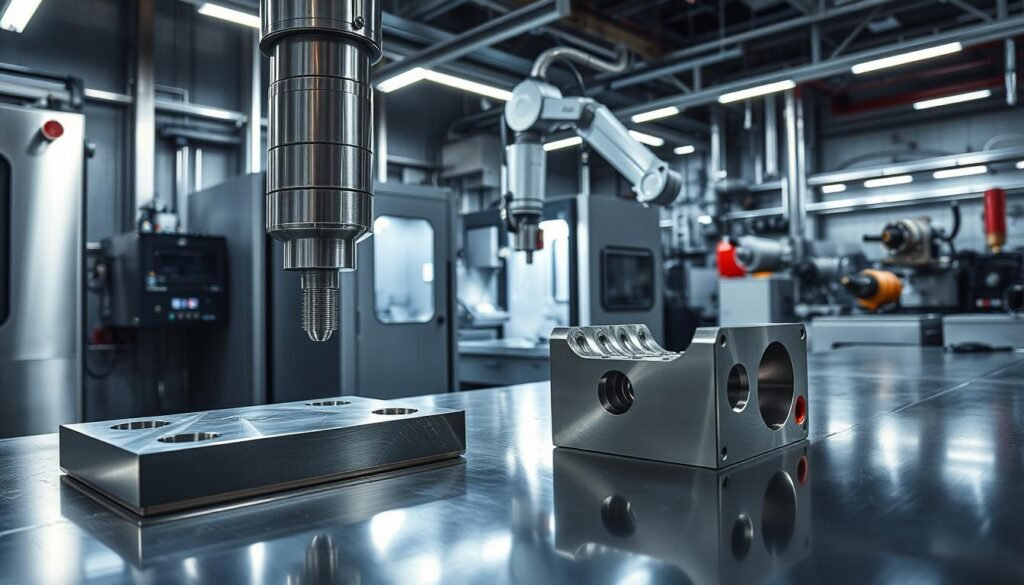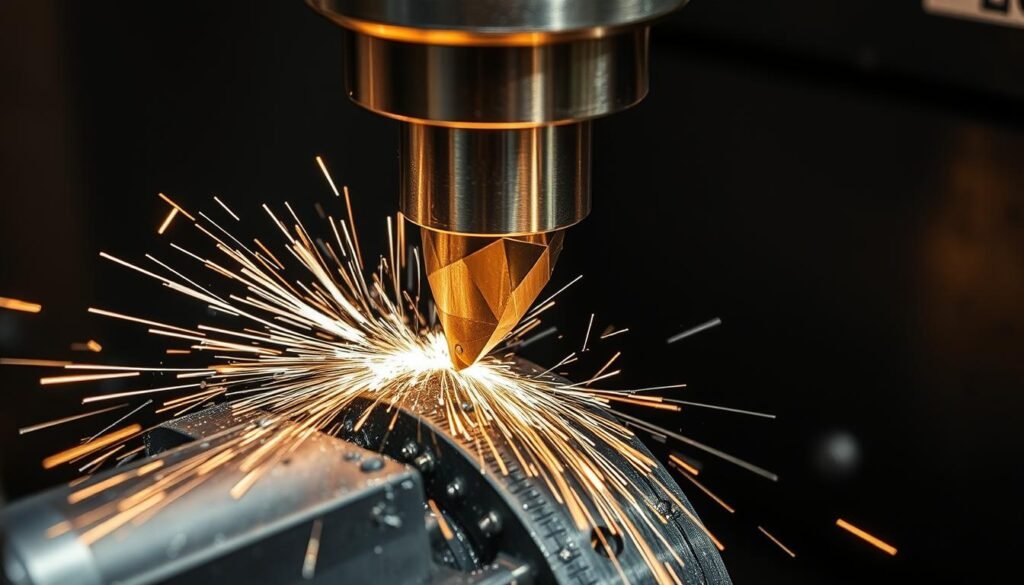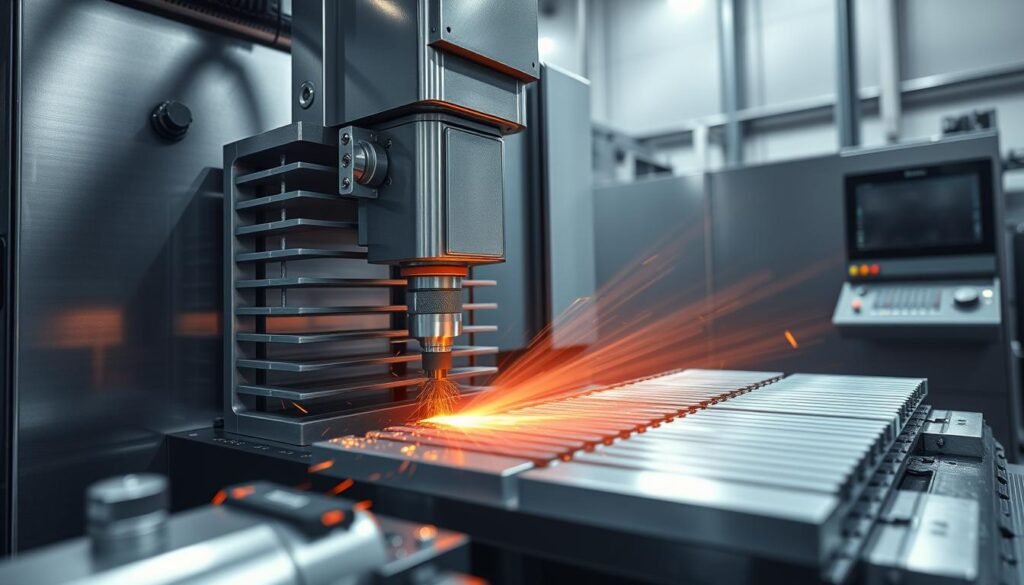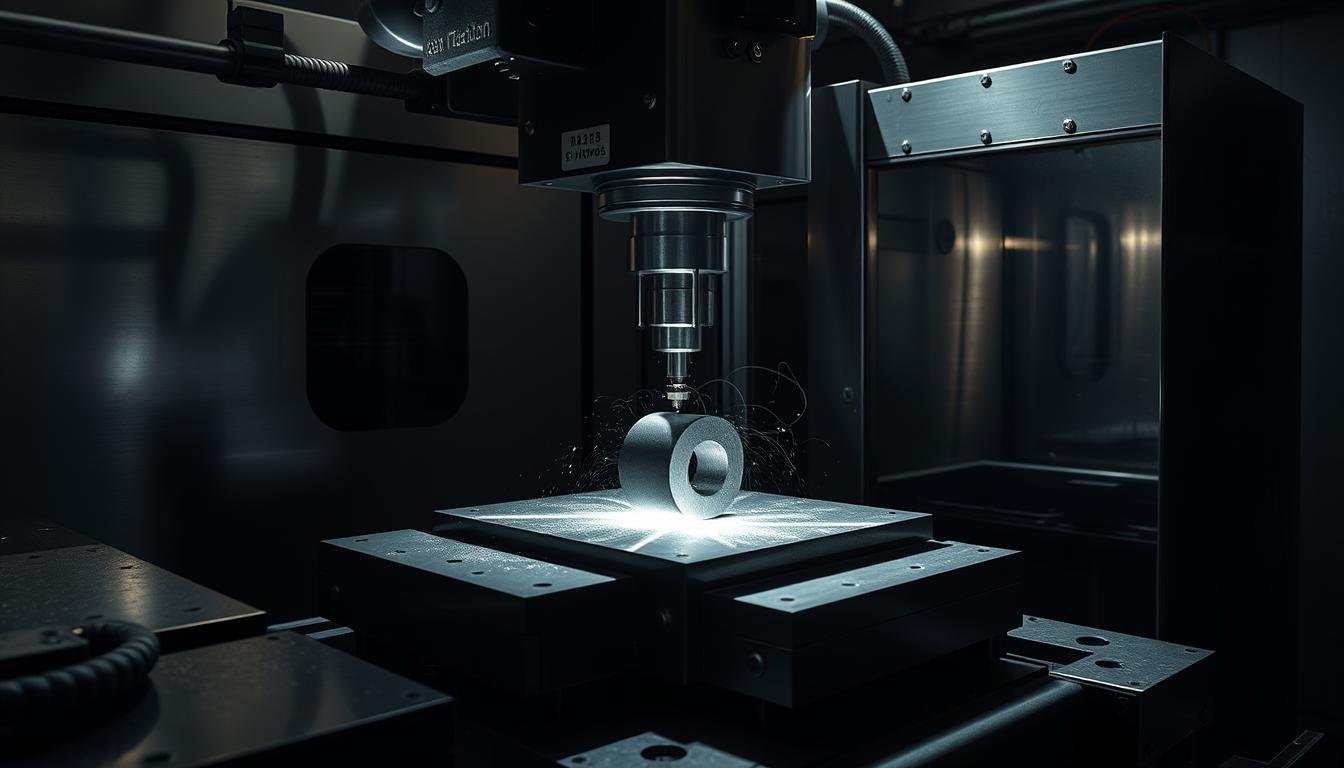Titanium is a top choice in advanced manufacturing. It’s strong, light, and doesn’t rust easily. It’s also safe for the body. But, these great traits also bring big titanium CNC machining challenges.
Working with titanium is tricky because it doesn’t hold heat well and bends easily. To beat these hurdles, we need smart CNC machining solutions. Knowing the problems and using new methods can make machining better and results better too.
Key Takeaways
- Titanium’s strength-to-weight ratio and corrosion resistance make it critical in aerospace, medical, and other cutting-edge applications.
- Manufacturers using Pure-Cut® report at least 2x longer tool life compared to conventional machining methods.
- Titanium CNC machining challenges include low thermal conductivity and susceptibility to elastic deformation.
- Traditional coolant systems often struggle with effective heat management, leading to tool wear and thermal deformation.
- Pure-Cut® CO2 cooling technology enhances chip flow, reduces burr formation, and aligns with eco-friendly manufacturing practices.
Introduction to Titanium CNC Machining
Titanium CNC machining is in high demand. This is because titanium is very strong and doesn’t rust easily. It’s used a lot in aerospace, medical, and car industries.

It’s important to know about titanium’s properties when machining it. Titanium is lighter than steel but just as strong. This makes it great for projects that need to be light but strong.
But, machining titanium is hard because it doesn’t conduct heat well. This can cause tools to wear out fast. Using special tips and services can help make machining titanium better.
When making titanium parts, you need to control how you cut it well. This helps save material and makes the parts better. The speed at which you cut titanium is important and needs careful planning.
To make things better, using special tools is key. These tools are made to handle the tough cutting and heat of titanium. They last longer and make the parts more precise.
Knowing how to machine titanium well is crucial for making good products. By using the right services and tips, companies can make the most of titanium’s benefits.
Understanding the Unique Properties of Titanium
Titanium is known for its amazing qualities. It’s very strong but also very light. This makes it perfect for cutting metal without being too heavy.
Strength and Lightweight Benefits
Titanium is elastic and bends a bit when tools press on it. But it’s still very strong. This is why it’s great for making things that are both light and strong.

To cut titanium, you need special tools that don’t break easily. Petersen Precision uses these tools to make parts that are just right. They also use fast machines to cut titanium without damaging it.
Applications in Aerospace, Medical, and Automotive Industries
Titanium doesn’t rust and is safe for the body. This makes it perfect for medical implants. It’s also used in cars to make them lighter and more fuel-efficient.
New tools and software help make complex shapes with precision. This makes making parts faster and easier. Using cool machines with special cooling systems also helps tools last longer.
Challenges Due to Titanium’s Low Thermal Conductivity
Titanium is hard to machine because it gets too hot. This can damage the tools. To fix this, new cooling methods are used.
Titanium makes long, stringy chips that are hard to get rid of. Using software to plan ahead and making the best tool paths helps. This makes making parts more efficient and cuts down on waste.
Titanium CNC Machining Challenges
Titanium is known for its strength and light weight. It’s only 40% as heavy as steel. But, making things out of titanium can be tricky.
One big problem is that titanium gets too hot during machining. It’s more flexible than steel, making it hard to work with. Also, it’s hard to cool down because it doesn’t conduct heat well.

Tools wear out fast when cutting titanium because of the heat. To avoid this, tools need to be changed often. It’s important to use tools that can handle high temperatures.
When titanium chips stick to tools, it makes them dull. Using coolants helps keep the tools sharp. Fusion’s Coolant Technologies use special cooling methods to help.
Special tools are needed to hold thin titanium parts in place. Without them, parts can be off by a lot. Choosing the right toolpath helps make parts more accurate.
When cutting titanium, the speed should be slow. This helps avoid damaging the material. The depth of each cut should also be controlled. Using coolants can also make the process safer.
Effective Heat Management Techniques
Managing heat in machining titanium is key because it conducts heat poorly. This part talks about smart ways to keep machining conditions right. It’s all about making sure our clients get the best quality and precision in their work.
Why Traditional Coolants Fall Short
Old coolants can’t handle the heat from machining titanium well. Titanium doesn’t conduct heat well, so these coolants don’t work. This leads to tools wearing out fast and parts not being as good as they should be.
Even with more force in cutting, these coolants can’t cool down the area. This means tools get worn out quicker and things aren’t as precise as they should be.
Introducing Fusion’s Pure-Cut® CO2 Cooling Technology
Fusion’s Pure-Cut® CO2 Cooling Technology is a new solution to these problems. It uses supercritical CO2 to move and cool heat better than old methods. This keeps the machining process steady and precise, cutting down on tool wear and making tools last longer.
This technology is a top choice for CNC machining, giving the best results in tough jobs.

Advantages of Supercritical CO2 (scCO2) in Cooling
Supercritical CO2 (scCO2) has many benefits over old cooling methods. It’s a big change in the machining world. Here are some of its main advantages:
- Effective Heat Dissipation: scCO2 can take heat away from the cutting area better than before.
- Enhanced Tool Life: Keeping tools cooler, scCO2 makes them last longer.
- Improved Surface Finish: scCO2 keeps the cooling right, making the surface of parts better.
- Environmental Impact: CO2 is good for the planet, making it a safer choice than old coolants.
A table shows how scCO2 is better than old coolants:
| Cooling Method | Heat Dissipation Efficiency | Tool Wear Rate | Surface Finish Quality |
|---|---|---|---|
| Conventional Coolants | Medium | High | Average |
| supercritical CO2 | High | Low | High |
Fusion’s Pure-Cut® CO2 Cooling Technology is a key part of our top CNC machining solutions. It helps our clients get the latest tech to meet their needs.
Dealing with Tool Wear and Selection
Choosing the right tools for titanium machining is key. It ensures quality and saves money. Titanium’s unique properties make tool wear a big challenge. This section talks about picking the best tools and making them last longer.
For CNC milling titanium, the best cutting speeds are 60-100 feet per minute. Start by picking tools that can handle titanium’s abrasive nature. For example, carbide tools work well but need specific speeds, like 3000 RPM.
Titanium’s high cutting forces need strong equipment. The heat from machining can be over 1000 °C. Keeping the tools cool is crucial to avoid damage.
When working with titanium alloys, controlling chips is important. Using dynamic and helical milling helps tools last longer and work better. The right spindle speeds and feed rates are also key for precise results.
High-pressure coolant systems can make tools last up to 30% longer. They help manage heat and reduce wear. The tool’s geometry is also important. For finishing titanium alloy TC4, a front angle of 8 to 15 degrees is best.
The type of cutting tool depends on the titanium grade. For example:
| Grade | Properties | Applications |
|---|---|---|
| Grade 1 | Excellent corrosion resistance, easy to machine | Chemical processing, medical applications |
| Grade 5 (Ti6Al4V) | High corrosion resistance, poor machinability | Airframe structures, medical devices |
| Grade 23 (Ti6Al4V-ELI) | Ideal biocompatibility, poor machinability | Orthopedic pins, surgical staples |
To extend tool life and cut costs, we need a detailed plan. This includes choosing advanced tools and optimizing machining. Precision machining services and following best practices help us work efficiently and maintain quality. For more tips on titanium machining, check out this resource.
Optimizing Cutting Parameters
Getting the right cutting parameters is key for good titanium machining. It’s all about finding the right balance for speed, feed rate, and depth of cut. This helps tackle the tough challenges titanium presents.
Balancing Cutting Speed, Feed Rate, and Depth of Cut
Titanium makes a lot of heat when machined, more than stainless steel. Its low heat spread makes it harder. So, picking the best cutting settings is crucial:
- Recommended cutting speeds for roughing: 25-38 m/min
- Finishing operations: 50-75 m/min
- Feed rates for rough machining: 0.10-0.15 mm/r
- Fine machining feed rates: 0.05-0.10 mm/r
- Depth of cut for titanium: 1-3 mm
Changing these settings can make titanium CNC machining better. It helps in cutting strong metal well without wearing out tools or damaging the workpiece.
Impact of Tool Path Optimization on Tool Life and Workpiece Quality
Planning tool paths well affects tool life and workpiece quality. By smart planning:
- Heat build-up is less, tools last longer.
- Cutting forces go down, making the surface smoother.
- Tools wear out slower, meaning less tool changes.
Using these methods also saves money and boosts productivity. It makes metal cutting more efficient in the long run.
Importance of Regular Tool Maintenance
Keeping tools in good shape is crucial for titanium machining. High temperatures and forces make tools wear out faster:
- Using carbide or CVD blades is best.
- High-pressure coolant helps keep temperatures down.
- Checking and replacing tools regularly is essential.
Regular maintenance keeps tools working well. It extends their life and keeps machining conditions optimal.
Innovative Machining Technologies
New technologies are changing CNC machining. They make titanium machining better and solve big challenges. These advancements improve how we work with strong materials like titanium.
IoT devices help us watch machining in real time. This makes our work more accurate and cuts down on mistakes. We can change settings as we go, making products better and more consistent.
New tool coatings like TiN and TiAlN are big improvements. They cut down on cutting forces and heat, making tools last longer. Carbide tools also last up to 30% longer, great for working with hard materials like titanium.
High-speed machining (HSM) makes work faster without losing precision. This is key in busy fields like aerospace and medical devices. Cryogenic machining also improves quality, making it better for sensitive materials like titanium and nickel alloys.
Cobot automation systems are changing how we work. They make production lines more efficient by doing routine tasks. This lets people focus on more important work, making things better and faster.
The industry is moving towards being more green. Mist cooling is a big step, cutting down on traditional fluids. It’s better for the planet and still keeps things cool and lubricated during machining.
Virtual simulation tools are also helping a lot. They let engineers test and fix problems before making things. This can cut down on mistakes by up to 20%, saving resources and reducing waste.
MES systems are making production more efficient. They collect and analyze data in real time. This helps find and fix problems fast, making things run smoother.
In summary, new technologies are making CNC machining better. From better tools and faster machining to being more green, these changes are setting new standards. By using these advancements, the machining industry is getting more precise, efficient, and sustainable.
Examples of Successful Titanium Machining Projects
We’ve done great work in precision machining for titanium across many fields like aerospace, medical, and automotive. Here are three big examples of how we tackled tough machining problems.
Case Study: Aerospace Component Machining
The aerospace world needs parts that are perfect and reliable. We used special aerospace machining methods to make top-notch titanium parts. We used coated tools and the right setup to cut down on shakes and get the best finishes.
Case Study: Medical Implant Manufacturing
In the medical world, our work on titanium implants is key. Titanium is safe for the body, making it great for implants. We set up the cutting just right to avoid mistakes and keep the implants smooth and precise.
Case Study: Automotive Parts Fabrication
We made strong, yet light, titanium parts for cars. We used smart tool paths and cool tech to keep tools sharp and avoid heat damage. This made parts that were both affordable and improved car performance.
These examples show how crucial it is to know aerospace machining and other areas well. We keep improving our methods and using new tools to offer the best precision machining services out there.
Conclusion
To beat titanium CNC machining hurdles, we need a full plan. This plan should mix tech, skills, and new ideas. Knowing titanium’s special traits helps us tackle its tough machining needs. Our piece talked about keeping cool during machining, showing how Fusion’s Pure-Cut® CO2 cooling tech is better than old coolants.
We looked at key tools and methods. These include setting up the right cutting settings and using advanced cooling systems. By focusing on tool wear and using top-notch fixturing, we cut down on setup times and costs. This leads to better quality in both small and big production runs.
In short, the need for top-notch titanium parts in fields like aerospace and medicine shows we must keep improving our CNC machining. By using the latest tech and keeping things in top shape, we can get better results. This shows our dedication to quality and excellence. We encourage everyone in the field to use these methods to boost their skills and meet today’s high standards.
FAQ
What are the main challenges in titanium CNC machining?
Titanium’s low heat conductivity and high strength can cause too much heat. This can wear down tools and damage the workpiece. Our precision machining services tackle these issues.
How does titanium’s thermal conductivity affect machining?
Titanium’s low heat conductivity means heat from cutting stays. This can lead to overheating and tool wear. Using the right cooling techniques is key for cutting high-strength metals.
What industries benefit the most from titanium CNC machining?
Titanium is key in aerospace, medical implants, and car parts. Its strength and lightness make it perfect for these fields.
Why do traditional coolants often fall short in titanium machining?
Old coolants can’t handle titanium’s heat well. This leads to poor performance and tool wear. Our Pure-Cut® CO2 Cooling Technology is a better choice.
What advantages does supercritical CO2 (scCO2) offer in cooling for titanium machining?
scCO2 cools better by taking and spreading heat well. This makes tools last longer and workpieces better.
How do we handle tool wear in titanium CNC machining?
We pick the right tools and use smart cutting settings. We also cool well and keep tools in good shape. This keeps tools working well.
What are the best practices for optimizing cutting parameters in titanium machining?
Finding the right speed, feed, and depth is key. Also, smart tool paths help tools last longer and workpieces look better. Keeping tools up is also important.
Can you share some examples of successful titanium machining projects?
Sure. We’ve done aerospace parts, medical implants, and car parts. These show our skill in precision machining and handling tough metals.


